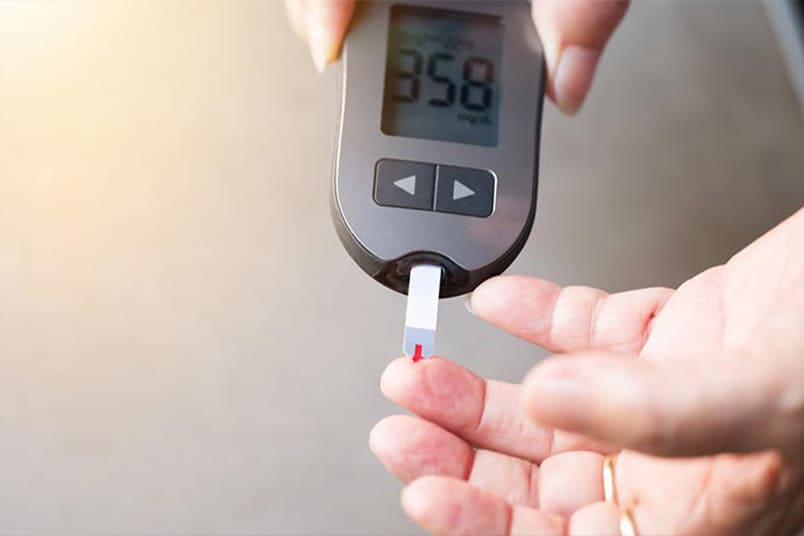Diabetic emergencies arise from imbalances in blood sugar levels and can pose serious threats to individuals with diabetes.
Two main emergencies include hypoglycaemia, resulting from low blood sugar, and hyperglycaemia, which occurs due to high blood sugar.
Undiagnosed and untreated hypoglycaemia may cause confusion and seizures, while hyperglycaemia may lead to diabetic ketoacidosis (DKA), characterized by dehydration and metabolic dysfunction.
Prompt recognition and appropriate intervention are vital for managing these emergencies and preventing complications.
Diabetic emergencies underscore the importance of consistent monitoring, proper medication adherence, and awareness to ensure the well-being of individuals living with diabetes.

Signs Symptoms of Diabetic Emergencies
Diabetic emergencies encompass both hypoglycaemia (low blood sugar) and hyperglycaemia (high blood sugar) conditions, each presenting distinctive signs and symptoms.
Hypoglycaemia (Low blood sugar)
· Shakiness and tremors: Sudden onset of trembling or shaking, often noticeable in the hands
· Sweating: Profuse sweating, even in the absence of physical exertion
· Paleness: Skin may become noticeably pale during a hypoglycaemic episode
· Rapid heartbeat: An increased heart rate, sometimes described as palpitation
· Dizziness: Feeling unsteady or dizzy, sometimes accompanied by blurred vision
· Fatigue: Sudden onset of fatigue or weakness, affecting overall energy levels
· Seizures: In severe cases, hypoglycaemia may lead to seizures, requiring urgent medical attention
Hyperglycemia (High blood sugar)
· Excessive thirst and hunger: Persistent feelings of thirst and hunger, often difficult to satiate
· Frequent urination: Increased need to urinate, especially during the night
· Blurred vision: Vision may become blurred or unfocused due to changes in fluid balance
· Fatigue and weakness: Generalized fatigue and weakness, hindering daily activities
· Dry mouth and skin: Excess loss of water from the body can lead to a dry mouth and parched skin
· Nausea and vomiting: Some individuals may experience nausea, and in severe cases, vomiting
· Shortness of Breath: Rapid, deep breathing may occur as the body attempts to compensate for metabolic imbalances
· Sweet or fruity breath/odour: A distinctive sweet or fruity odour on the breath may indicate the presence of ketones in diabetic ketoacidosis (DKA)
· Confusion: Cognitive impairment and confusion can develop as hyperglycaemia progresses
Diagnosis of Diabetic Emergencies
Diagnosing diabetic emergencies involves recognizing specific signs and symptoms associated with both hypoglycaemia and hyperglycaemia and using appropriate diagnostic tools. The following are the various diagnostic procedures and tools:
A.Clinical Assessment
Hypoglycaemia: The clinical diagnosis involves evaluating the presence of characteristic symptoms such as shakiness, sweating, confusion, and irritability. Blood glucose monitoring using a glucometer confirms low blood sugar levels.
Hyperglycaemia: Clinical assessment includes signs such as excessive thirst, frequent urination, and fatigue. Blood glucose levels above the normal range, typically confirmed through blood tests, establish the diagnosis.
B. Blood Glucose Monitoring
Hypoglycaemia: Immediate assessment of blood glucose levels using a glucometer is essential. A reading below the normal range (usually less than 70 mg/dL) indicates hypoglycaemia.
Hyperglycaemia: Blood glucose levels exceeding the normal range (often above 180 mg/dL for fasting or 200 mg/dL for random measurements) indicate hyperglycaemia.
C. Laboratory Tests
Hypoglycaemia: Additional laboratory tests may be conducted to identify underlying causes, such as insulin or medication overdoses. C-peptide and insulin levels help differentiate between exogenous insulin use and endogenous insulin production.
Hyperglycaemia: Haemoglobin A1c levels provide insight into long-term blood glucose control. Assessment of ketones in the urine or blood is crucial for identifying diabetic ketoacidosis (DKA), a severe form of hyperglycemia.
D. Electrolyte Assessment
The electrolyte levels can be altered in both hypo and hyperglycaemia conditions. In cases of DKA, electrolyte imbalances such as low potassium levels can be assessed through blood tests.
Timely diagnosis is essential for appropriate intervention and preventing complications associated with diabetic emergencies. Management strategies vary based on the specific emergency, emphasizing the importance of individualized care and prompt medical attention.
Treatment of Diabetic Emergencies
Diabetic emergencies, stemming from imbalances in blood sugar levels, require distinct interventions tailored to the specific condition.
Hypoglycaemia
Immediate Treatment
· Consume fast acting carbohydrates: Individuals experiencing hypoglycaemia should ingest glucose rich sources, such as glucose tablets, fruit juice, or regular soda. Avoid high fat foods, as they can slow down sugar absorption.
· Recheck blood sugar: After 15 minutes, recheck blood sugar levels. If still low, repeat the carbohydrate intake.
· Complex carbohydrate consumption: Following stabilization, consume complex carbohydrates like whole grains to sustain blood sugar levels.
Emergency Situations
· Glucagon injection: In severe cases where the person is unconscious or unable to swallow, a glucagon injection can be administered. Family members or caregivers should be trained to use this emergency injection.
· Emergency medical assistance: If the individual does not respond to treatment or loses consciousness, seek immediate medical help.
Hyperglycaemia
Immediate Treatment
· Hydration: Drink water or other sugar-free, non-caffeinated beverages to counteract dehydration. Hydration helps flush out excess glucose through urine.
· Insulin adjustment: For those using insulin, follow healthcare provider recommendations for adjusting insulin doses.
· Monitor blood sugar levels: Regularly check blood sugar levels to monitor the effectiveness of interventions.
· Contact healthcare provider: Seek guidance from a healthcare professional to determine if additional insulin or medication adjustments are necessary.
· Diabetic ketoacidosis (DKA): If symptoms of DKA (sweet or fruity breath, confusion, vomiting) are present, immediate medical attention is crucial as DKA requires hospitalization and intravenous fluids.
· Emergency services: In severe cases, especially if unconsciousness or persistent symptoms occur, call emergency services.
Preventive Measures
· Regular monitoring: Consistent blood sugar monitoring helps detect trends and allows for proactive adjustments in medication or lifestyle.
· Adherence to medications: Strict adherence to prescribed medications, including insulin, is crucial in preventing fluctuations.
· Individualized management plans: Work with healthcare providers to develop personalized diabetes management plans, accounting for diet, exercise, and medication adjustments.
In summary, diabetic emergencies necessitate prompt and appropriate action. Individuals with diabetes, their families, and caregivers should be educated on recognizing symptoms and administering initial treatments.
Timely intervention, coupled with preventive measures, is key to managing diabetic emergencies effectively and minimizing the risk of complications.
Regular communication with healthcare providers is essential for ongoing diabetes care and prevention of emergency situations.
KM NU Hospitals, Ambur, India, exhibit excellence in treating diabetic emergencies. Their dedicated healthcare professionals prioritize prompt and effective interventions for both hypoglycaemia and hyperglycaemia. With a focus on individualized care, regular monitoring, and advanced medical expertise, KM NU Hospitals ensure comprehensive management of diabetic emergencies, contributing to the well-being and improved outcomes for individuals facing such critical situations.
References:
1. Diabetes Care during Emergencies Centres for Disease Control and Prevention https://wwwcdcgov/diabetes/library/features/diabetescareduringemergencieshtml.
2. Diabetes in Emergency American Diabetes Association https://diabetesorg/toolsresources/disasterrelief/caringpeoplediabetesemergency.
3. Emergency Management of Diabetes National Library of Medicine https://wwwncbinlmnihgov/pmc/articles/PMC2464424/
Author: Dr. Sivakumar Ramaswamy
